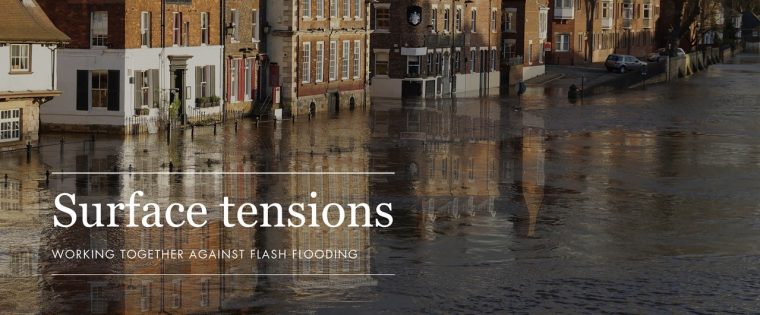Flash flood plans should touch on surface risks, Localis report warns

Responsibility for tackling the growing prevalence of flash surface flooding should be gripped by central and local government to prevent needless damage to property and human misery, the think-tank Localis has argued.
In a report published today entitled ‘Surface Tensions – working together against flash flooding’ the place experts argued the connection between increased urbanisation and surface water risk demand greater coordination between the public sector, developers and wider society.
The study found the separation of roles and responsibilities for managing and forecasting the impact flood risk are fragmented between a slew of government departments, agencies and local bodies, resulting in confusion when flooding does occur.
Of particular note, the report found that minor developments comprising nine houses or less, infill or permitted development – are aggregating the risk of surface flooding across an area, without a legal requirement to provide sustainable drainage. Official figures for the year to June 2022 show that 35,000 dwellings received planning decisions from local authorities where more than one percent of homes are already at risk of flooding as part of minor developments. Given that 73% of minor development applications were approved across England in the same period, this could mean as many as 25,550 new homes built in areas that are already at risk of flash flooding, increasing pressure on infrastructure.
Among its key recommendations to reduce risk of surface flooding from climate change, Localis calls for the creation of a strong strategic planning authority with power for force national and local risk management authorities, such as the Environment Agency, Lead Local Flood Authorities (LLFAs) to work closely together and link up policy.
The report also calls for stronger collaboration between developers, landowners, LLFAs and central government agencies to understand and manage flood risk and resilience, and for this to be encouraged and incentivised across all new developments.
Localis Visiting Fellow, Professor Samer Bagaeen, said: “To tackle surface flooding, the next revision of the National Planning Policy Framework must require Local Plans to demonstrate how lead local flood authorities have assessed aggregate risk across the whole area, as well as how flood impacts will avoided, controlled, mitigated, and managed.
“And at the level of place, for infrastructure and procurements concerning flooding, lead local flood authorities should move away from human-engineered barriers and toward natural drainage systems that work to slow the flow of surface water and relieve pressure on sewers.”
Joe Fyans, Localis head of research, said: “As the UK is experiencing extremely wet days – more days of heavy summer rainfall on impermeable ground as well as a significant increase in heavy winter rainfalls – we are seeing an unsurprising increase the incidence of surface water flooding.
“How we go about funding this will be crucial. Central government would be best advised to pproduce a comprehensive flood infrastructure funding programme that is less restrictive and targeted toward places most at risk, while also encouraging ‘bottom-up’ practice by streamlining the funding process for smaller, district or community-based projects.”
Martin Milliner, claims director at LV= General Insurance, said: “As an insurer we see first-hand the very real and devastating impact flooding has on people’s lives. While we know the building of more homes is necessary to combat the housing crisis, the country is becoming less resilient to more extreme weather, and we must look at the future impacts this will have on our homes.
“The report highlights significant issues that continue to put an ever-increasing number of communities at risk, and it’s crucial that property developers, insurers and local authorities work together to tackle this important issue.”
“With the creation of our Flood-Proof Home of the Future we want to draw attention to the impact flooding could have on this country in 50 years, by showcasing the extreme features homes of the future may need to have to guard against flood risk. With the installation of such sophisticated flood proofing practically and financially out of the question for most homeowners, it’s more important than ever we work to combat the problem before such extreme measures are necessary.”
A copy of the report can be found here: “Surface Tensions – working together against flash flooding”
